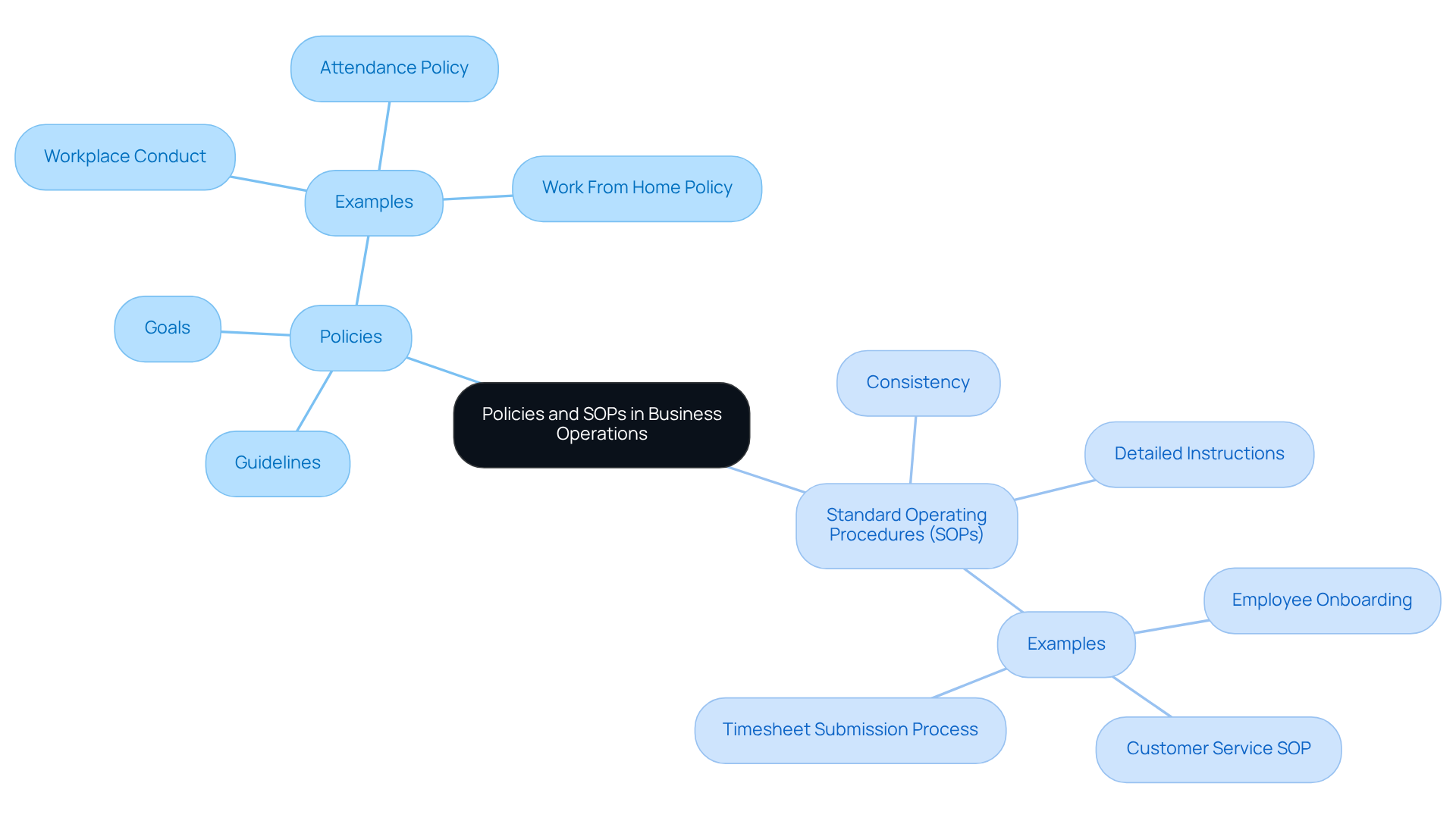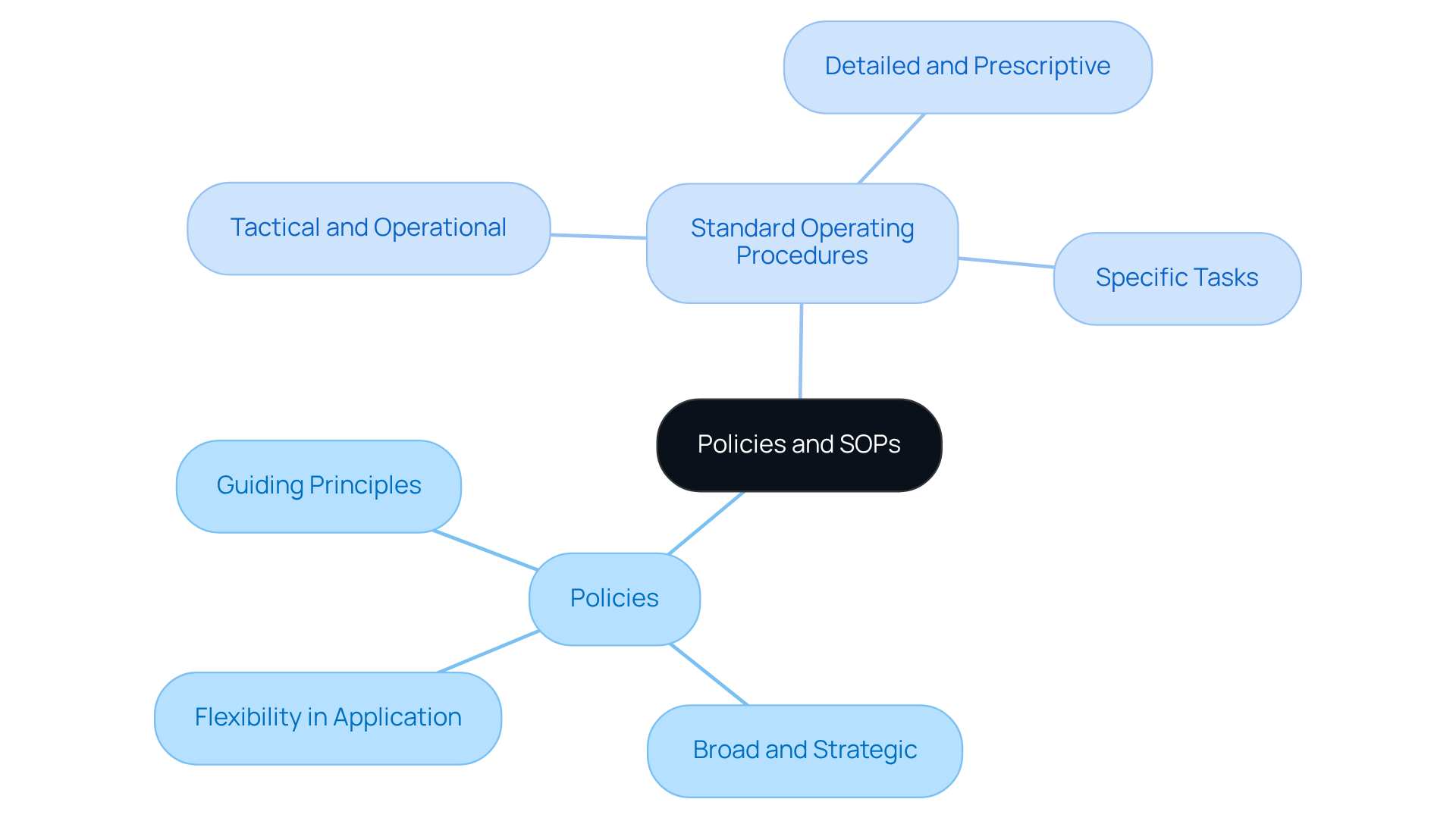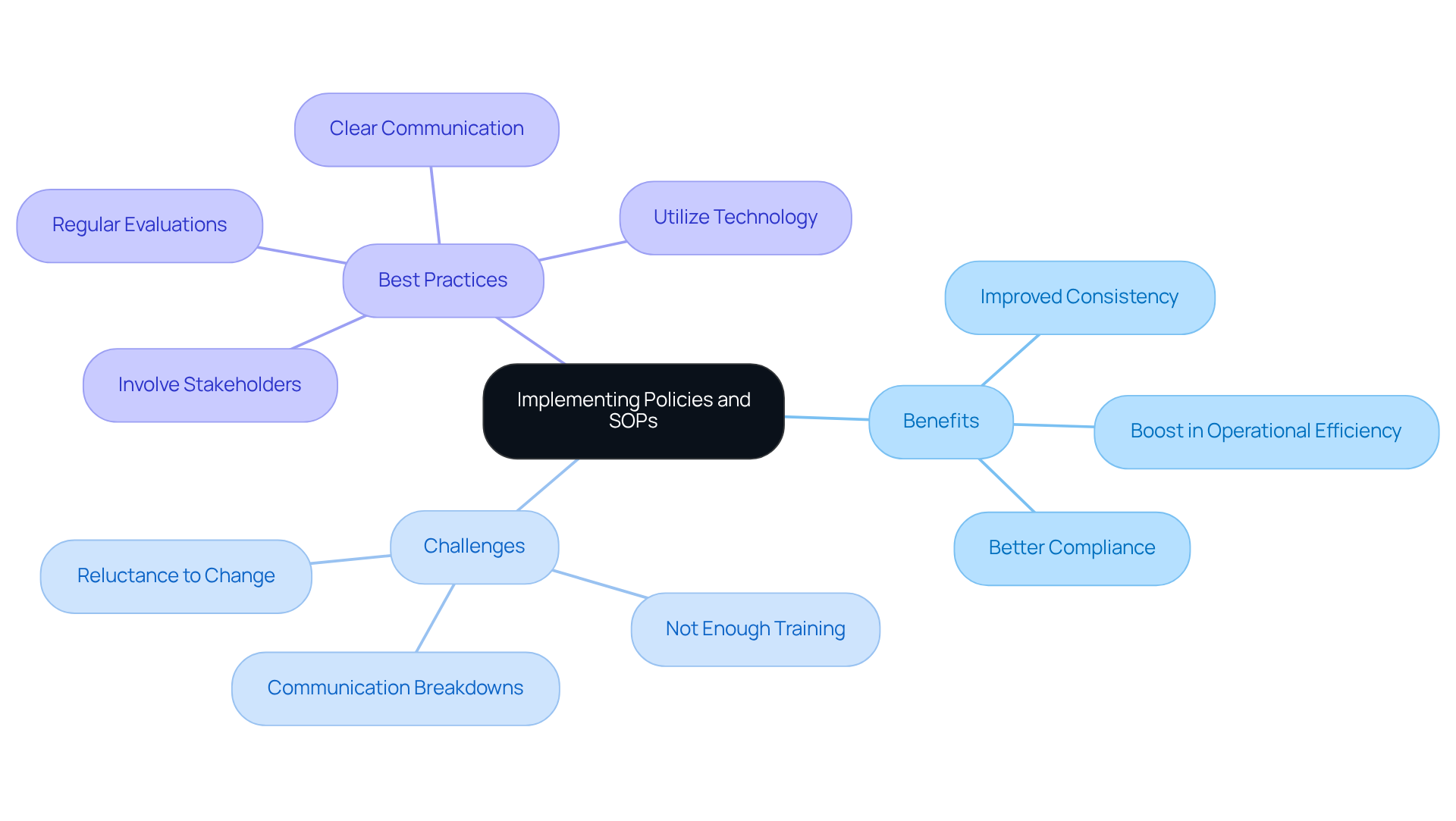
Process Improvement through Documentation
|
October 17, 2025
|
Policies vs. SOPs: Key Differences Every Operations Manager Should Know
Overview
You might be wondering what the real differences are between policies and Standard Operating Procedures (SOPs). Well, it’s pretty simple! Policies are like the big picture—broad guidelines that help shape behavior and decision-making. On the other hand, SOPs dive into the nitty-gritty, providing detailed instructions for specific tasks.
Understanding these distinctions is super important for operations managers. Why? Because when both are implemented effectively, it can lead to improved consistency, compliance, and overall operational efficiency. Plus, there’s evidence showing that organizations with clear documentation often see increased revenue and reduced employee attrition.
So, let’s explore how getting these right can make a difference for you!
Key Highlights:
- Policies serve as broad guidelines that outline a company's principles and expectations for behaviour.
- Standard Operating Procedures (SOPs) provide detailed, step-by-step instructions for specific tasks within an organisation.
- Together, policies and SOPs create a structured operational framework, ensuring clarity in roles and responsibilities.
- Only 1 in 100 businesses has documented practises guidelines, which can lead to confusion and inefficiencies.
- Effective implementation of policies and SOPs can lead to improved consistency, compliance, and operational efficiency.
- Common challenges in implementing these guidelines include resistance to change, inadequate training, and communication issues.
- Best practises for implementation include involving stakeholders, regular evaluations, clear communication, and utilising technology.
- Organisations that prioritise clear documentation can experience increased revenue and lower attrition rates.
Introduction
You might be wondering why understanding the difference between policies and standard operating procedures (SOPs) is so important for an operations manager like you. Well, here’s the scoop: while policies lay down the big-picture principles that guide behavior and decision-making, SOPs dive into the nitty-gritty, offering the tactical instructions you need to get specific tasks done.
In this article, we’ll explore the key differences between these two essential components of business operations, shining a light on their unique roles and the significant impact they have on efficiency and compliance.
Now, let’s think about what happens when these frameworks are a bit fuzzy or, worse, ignored altogether. The fallout can be pretty severe, leading to confusion and inefficiencies that can really throw a wrench in your organization’s performance.
Define Policies and SOPs: Core Concepts in Business Operations
Policy SOP serves as friendly guidelines that outline a company’s principles and rules, thereby creating a solid framework for decision-making and behavior. They give a broad overview of the organization’s goals and what’s expected from employees. You might be wondering how this plays out in real life—well, a workplace conduct policy, for example, might outline acceptable behaviors among staff, helping to ensure everyone is on the same page in creating a cohesive work environment.
Now, let’s dive into Standard Operating Procedures (SOPs). These are your go-to detailed, step-by-step instructions for carrying out specific tasks or processes within the organization. Think of SOPs as the backbone of consistency and quality in operations, providing clear guidelines on how to get things done. For instance, an SOP could lay out the exact steps for onboarding a new employee, including all the necessary paperwork and training protocols.
Together, guidelines and policy SOP create a structured operational framework, ensuring that every team member knows their roles and responsibilities. By utilizing SowFlow's solution, operations managers can easily create and update user guides for both policy SOP and other processes, boosting clarity and accessibility. This is crucial for reducing risks and ensuring compliance, as it allows for quick updates to meet changing organizational needs. As Owen McGab Enaohwo points out, not having clearly defined procedures can lead to business failures, highlighting just how important guidelines and SOPs are for achieving organizational success.
Did you know that by 2025, it’s estimated that only 58 percent of companies offering flexible work arrangements will have formal work-from-home guidelines? This really underscores the need for thorough development to effectively guide organizational behavior. By grasping these core concepts and leveraging SowFlow's user-friendly documentation tools, operations managers can tackle the complexities of their roles and boost overall organizational effectiveness.

Contrast Policies and SOPs: Key Differences and Applications
You might be wondering how the policy SOP and standard operating procedures integrate into the big picture of business operations. While both are crucial, they actually serve different purposes. Think of policies as your organization's guiding principles—broad and strategic, they help direct behavior and decision-making across the board. They’re often less detailed, which means there’s room for interpretation and flexibility in how they’re applied.
Now, let’s talk about standard operating procedures, or SOPs for short. These are more tactical and operational, focusing on the nitty-gritty of specific tasks and processes. SOPs are detailed and prescriptive, leaving little room for interpretation. This distinction is super important: while strategies set the overall direction for the organization, the policy SOP ensures that daily operations are aligned with those strategies.
For example, a company might have a policy stating that all staff must safeguard sensitive information. The corresponding SOP would lay out the exact steps employees need to follow—think password requirements, encryption methods, and how to report data breaches. Understanding these differences helps operations managers execute both effectively, ensuring that guidelines are followed through clear procedures.
But here’s a surprising fact: only 1 in 100 businesses has documented practices guidelines. This can lead to confusion and inefficiencies, especially during onboarding. It really highlights the need for organizations to establish clear guidelines. When companies successfully blend their policy SOPs, they often see improvements in compliance and operational effectiveness. For instance, a major retail chain standardized its complaint resolution system, resulting in a 30% boost in customer service ratings. That’s a pretty compelling reason to get it right!
Moreover, organizations that prioritize clear documentation can experience a 30% increase in revenue and lower attrition rates. By grasping how guidelines and SOPs interact, operations managers can create a more organized and effective work environment, ultimately driving success. Engaging key stakeholders in crafting these guidelines further enhances clarity and ownership, making sure that both the regulations and SOPs are relevant and executed efficiently. And speaking of relevance, did you know that 79% of organizations are either already using, testing, or considering AI to help with compliance and risk management? It’s a clear sign that the landscape of regulations and SOP management is evolving!

Implement Policies and SOPs: Benefits, Challenges, and Best Practices
You might be wondering why implementing policy SOPs is such a big deal. Well, let me tell you, it comes with some serious perks! Think improved consistency, better compliance, and a boost in operational efficiency. When you have clear policies in place, employees know exactly what’s expected of them. Plus, standard operating procedures help everyone execute tasks consistently, which means fewer mistakes and a whole lot more productivity.
But it’s not all smooth sailing. Many organizations hit some bumps in the road when it comes to execution. Common challenges include a reluctance to change, not enough training, and communication breakdowns. These hurdles can really throw a wrench in the works when trying to roll out new guidelines and procedures. So, how do we tackle these issues? It’s all about prioritizing staff engagement, providing thorough training, and making sure that everyone has easy access to the necessary documentation.
Now, let’s talk about some best practices for implementing policies and SOPs that can make a real difference:
- Involve stakeholders: Get your employees involved in the development process! This not only fosters buy-in but also ensures that the policies are relevant to their day-to-day work.
- Regular evaluations: Don’t just set it and forget it! Make it a habit to regularly assess and update your guidelines and procedures to keep them in line with any organizational changes or industry standards.
- Clear communication: It’s crucial that all employees understand the guidelines and procedures and recognize their importance in daily operations.
- Utilize technology: Embrace tools like SowFlow to streamline the creation and management of your policies and SOPs. This way, they’ll always be accessible and up-to-date.
By following these best practices, you can really amp up the effectiveness of your documentation strategies. This leads to a more structured and efficient operational environment, making it easier for everyone to do their best work!

Conclusion
You might be wondering why understanding the difference between policies and standard operating procedures (SOPs) is so important for operations managers. Well, it’s all about boosting organizational efficiency! Think of policies as the broad guiding principles that help shape decision-making and behavior, while SOPs give you the detailed instructions for executing specific tasks. This clear distinction helps organizations build a structured operational framework that aligns daily actions with their bigger strategies.
Now, while policies offer that much-needed flexibility and strategic direction, SOPs are all about precision and consistency in execution. By integrating both, you create a cohesive work environment that not only reduces risks but also enhances compliance. Plus, getting stakeholders involved in the development process and leveraging technology can really amp up the implementation of these guidelines, driving your organization toward success.
In today’s fast-paced business world, you can't underestimate the value of well-defined policies and SOPs. Organizations that focus on clarity and documentation don’t just improve operational effectiveness; they also set themselves up for long-term growth and stability. So, embracing best practices in developing and implementing these frameworks is key to navigating challenges and achieving sustained success. Why not explore how you can apply these insights in your own organization?
Frequently Asked Questions
What are Policies and SOPs in business operations?
Policies serve as guidelines that outline a company’s principles and rules, establishing a framework for decision-making and behavior. Standard Operating Procedures (SOPs) are detailed, step-by-step instructions for carrying out specific tasks or processes within the organization.
How do Policies impact workplace behavior?
Policies, such as workplace conduct policies, outline acceptable behaviors among staff, helping to ensure a cohesive work environment where everyone understands what is expected.
What is the purpose of Standard Operating Procedures (SOPs)?
SOPs provide clear guidelines on how to perform specific tasks, ensuring consistency and quality in operations. For example, an SOP may detail the steps for onboarding a new employee, including necessary paperwork and training protocols.
How do Policies and SOPs work together?
Together, Policies and SOPs create a structured operational framework that clarifies roles and responsibilities for every team member, enhancing overall organizational effectiveness.
What tools can help in creating and updating Policies and SOPs?
SowFlow's solution allows operations managers to easily create and update user guides for both Policies and SOPs, improving clarity and accessibility.
Why are clearly defined Policies and SOPs important?
Clearly defined Policies and SOPs are crucial for reducing risks and ensuring compliance, as they allow for quick updates to adapt to changing organizational needs. Lack of clear procedures can lead to business failures.
What is the significance of formal work-from-home guidelines?
By 2025, it is estimated that only 58 percent of companies offering flexible work arrangements will have formal work-from-home guidelines, highlighting the need for thorough development to effectively guide organizational behavior.
How can operations managers benefit from understanding Policies and SOPs?
By grasping these core concepts and using user-friendly documentation tools, operations managers can navigate the complexities of their roles and enhance overall organizational effectiveness.
👍
What others are liking
5 Steps to outline your ideal documentation structure
5 MINS READ
Where to start the your journey of mapping out your ideal documentation structure, aligning it with the very heartbeat of your organization?
Defining a winning level of detail in your process
3 MINS READ
What is too much detail, and what is too little? This article described in that winning level detail about what detail is enough.





